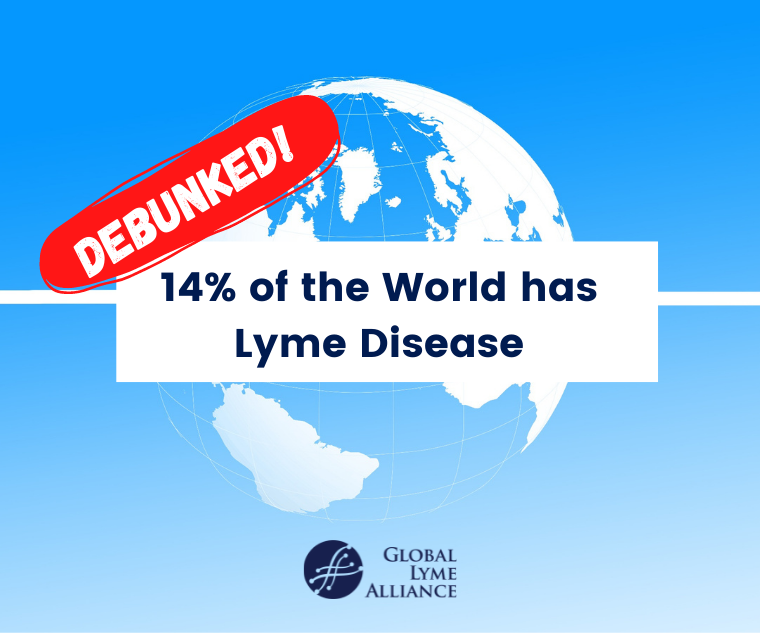
A recent article written for Today.com went viral after the title stated, "Lyme disease has infected over 14% of world population, new study finds." In this article, GLA's Chief Scientific Officer will explain why that statement is misleading.
Lyme disease, whose causative agent is the bacteria Borrelia burgdorferi (Bb), is the most frequent and growing tick-transmitted disease in North America and Europe. Despite being a global public health problem, it remains incompletely understood what percentage of the world population has been infected and what specific risk factors increase the likelihood of Bb infection.
Recently, news that “Lyme disease has infected 14.5% of the world” went viral after the publication of a study by Dong et al. This claim is based on the author’s rather provocative statement that “The reported estimated global Bb seroprevalence was 14.5%...”. However, careful review of the data shows that 14.5% of the global population of ~7.95 billion people (or ~1.15 billion individuals) have not, in fact, had Lyme disease. What was found is that 14.5% of 158,287 participants who were at high risk of tick-borne disease (or 22,952 people) from various studies analyzed by the authors had antibodies against the Lyme bacteria in their blood, suggesting they had Lyme disease. This does not mean that the Dong study was lacking, just that one should not over or misinterpret results. In fact, this first-in-kind study is comprehensive and expands our understanding of people exposed to the Lyme bacteria on a global scale in very important ways. Let’s break down why this study is important, the findings and their limitations, and what should be done next.
Dong et al. conducted a systematic review and meta-analysis of the scientific and medical literature to “get a handle” on worldwide Lyme disease seroprevalence (the number of persons in a population who test positive for a specific disease). They analyzed over 4,000 studies published between 1999 and 2021 and conducted in 28 countries from the Americas (5), Europe (17), Asia (4), Australia (1) and the Caribbean region (1).Of these, 58 were chosen for comprehensive scientific review and statistical analysis.
Dong and colleagues concluded that the top three regions of exposure to Lyme bacteria were Central Europe (20.7%), Eastern Asia (15.9%) and Western Europe (13.5%). Overall, exposure to Lyme bacteria was highest in individuals with Lyme disease-like symptoms (21.3%), followed by those with a history of tick bite (18.8%) and those at high risk of tick bites (14.7%), followed by the general population with the lowest exposure to Lyme bacteria (5.7%). In North America, exposure to Lyme bacteria was 14.2%, 30.4%, 27.8% and 1.2%, respectively. Additionally, review of data from the 58 studies revealed that potential risk factors associated with exposure to Lyme bacteria were male sex, age >40 years, residence in rural areas, and suffering tick bites.
Despite the scope of their analysis, it is important to appreciate the preliminary nature and limitations of the Dong study, as acknowledged by the authors themselves. Some of the studies used only an ELISA test rather than the standard two-tier assay. The rates of exposure to Lyme bacteria also are preliminary estimates because of the large heterogeneity (wide variation) in data from the included studies. Of possible explanations for this variation, a small sample size (less than 200,000 individuals from a global population of 7.9 billion people) from which data was analyzed is a likely contributing factor. To address such variation and obtain more globally representative estimates of Lyme disease cases, more extensive and prospective studies need to be conducted. This includes determining Lyme exposure rates in sites around the world where the general population’s risk of contracting a tick-borne infection is small if not non-existent. Only then can you more accurately extrapolate what the true global exposure to Lyme bacteria might be.
In summary, groups of people more likely to encounter ticks due to gender, age, profession, and where they live, are more likely to have antibodies against the Lyme bacteria. We do not, however, know the true worldwide exposure rate to Lyme bacteria, but it is likely much less than 5.7% of the general population as there is no indication that the studies the authors chose to include covered areas of the world where Lyme disease does not exist.
Nevertheless, it is great that Lyme disease is getting all this attention because it is a growing problem. According to the Environmental Protection Agency, Lyme disease cases in the United States have nearly doubled since 1991. Similar increases are likely occurring globally as a result of climate change, which has contributed to the expanded range of ticks that cause many bacterial, parasitic, and viral infections in addition to Lyme disease. Coupled with the Centers for Disease Control and Prevention’s revised estimate, suggesting that each year approximately 476,000 Americans are diagnosed and treated for Lyme disease, this particular tick-transmitted illness is a clear, present, and growing public health danger.

Timothy Sellati, P.h.D.
Chief Scientific Officer at Global Lyme Alliance
Timothy J. Sellati, PH.D. is Chief Scientific Officer at Global Lyme Alliance As GLA’s Chief Scientific Officer, Dr. Sellati leads GLA’s research initiatives to accelerate the development of more effective methods of diagnosis and treatment of Lyme and other tick-borne diseases.